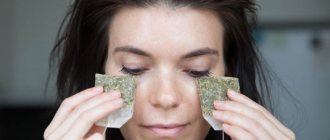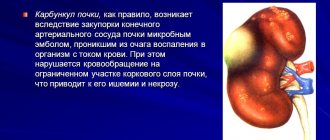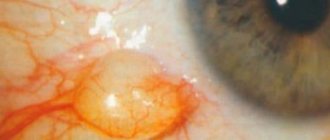Sjogren's disease is a systemic autoimmune disease related to connective tissue diseases; characterized by damage to many secreting glands, mainly salivary and lacrimal.
There is also Sjögren's syndrome (damage to the lacrimal and salivary glands), which accompanies rheumatoid arthritis, diffuse connective tissue diseases, diseases of the biliary system and other autoimmune diseases.
Sjogren's disease is the most common disease among connective tissue diseases and occurs in women 10–25 times more often than in men, usually between the ages of 20–60 years, and is much less common in children.
The causes of the disease are unknown. Most researchers consider Sjögren's disease as a consequence of immunopathological reactions to a viral infection, presumably retroviral.
Manifestations of Sjögren's disease
Symptoms of Sjogren's disease can be divided into glandular and extraglandular.
Glandular manifestations are caused by damage to the secreting glands, characterized mainly by a decrease in their function.
A constant sign of damage to the lacrimal glands in Sjögren's disease is eye damage associated with decreased secretion of tear fluid. Patients complain of burning sensations, “scratching” and “sand” in the eyes. Often there is itching of the eyelids, redness, and accumulation of viscous white discharge in the corners. Later, photophobia, narrowing of the palpebral fissures appear, and visual acuity decreases. Enlargement of the lacrimal glands in Sjögren's disease is rare.
The second mandatory and constant sign of Sjogren's disease is damage to the salivary glands with the development of chronic inflammation. It is characterized by dry mouth and enlarged salivary glands.
Often, even before the appearance of these signs, dryness of the red border of the lips, seizures, stomatitis, enlargement of nearby lymph nodes, and multiple (usually cervical) dental caries are noted. In a third of patients, a gradual enlargement of the parotid glands is observed, leading to a characteristic change in the oval of the face, described in the literature as a “hamster face” or “chipmunk face.”
In the initial stage of the disease, dry mouth appears only during physical activity and anxiety.
In the severe stage, dry mouth becomes constant, accompanied by the need to drink dry food and the desire to moisten the mouth during a conversation. The oral mucosa becomes bright pink and is easily injured. There is little free saliva, it is foamy or viscous. The tongue is dry. The lips are covered with crusts, inflammation is observed, and a secondary infection, including fungal and viral, may occur. Multiple cervical dental caries is characteristic.
The late stage is manifested by severe dryness of the mouth, the inability to speak, or swallow food without washing it down with liquid. The lips of such patients are dry, cracked, the oral mucosa shows signs of keratinization, the tongue is folded, and free saliva in the oral cavity is not detected.
Dryness of the nasopharynx with the formation of dry crusts in the nose and in the lumen of the auditory tubes can lead to temporary deafness and the development of otitis media. Dryness of the pharynx and vocal cords causes hoarseness.
Frequent complications are secondary infections: sinusitis, recurrent tracheobronchitis and pneumonia. Damage to the glands of the external genitalia is observed in approximately 1/3 of patients with Sjogren's disease. The vaginal mucosa is reddened, dry, and patients are often bothered by burning pain and itching.
A common symptom of Sjögren's disease is dry skin. Sweating may be reduced.
Swallowing problems are caused by dry mucous membranes. Many patients develop chronic atrophic gastritis with severe secretory insufficiency, clinically manifested by heaviness and discomfort in the epigastric region after eating, belching of air, nausea, and loss of appetite. Pain in the epigastric region is less common.
There is a direct relationship between the degree of dryness and inhibition of the secretory function of the stomach. Damage to the bile ducts (cholecystitis) and liver (hepatitis) is observed in most patients. There are complaints of heaviness and pain in the right hypochondrium, bitterness in the mouth, nausea, and poor tolerance to fatty foods.
Involvement of the pancreas in the process (pancreatitis) is manifested by pain and digestive disorders.
Extraglandular manifestations of Sjögren's disease are very diverse and systemic in nature. Joint pain, slight stiffness in the morning. Signs of muscle inflammation (muscle pain, moderate muscle weakness, slight increase in the level of creatine phosphokinase in the blood) are observed in 5–10% of patients.
In most patients with Sjögren's disease, there is an increase in the submandibular, cervical, occipital, supraclavicular lymph nodes, and in 1/3 of patients the enlargement of the lymph nodes is widespread. In the latter case, liver enlargement is often detected.
Various respiratory tract lesions are observed in 50% of patients. Dry throat, soreness and scratching, dry cough and shortness of breath are the most common complaints.
In Sjögren's disease, vascular damage is observed. Pinpoint bloody rashes most often appear on the skin of the legs, but over time they spread higher and can be found on the skin of the thighs, buttocks and abdomen. The rash is accompanied by itching, painful burning and increased skin temperature in the affected area.
Damage to the nervous system with sensory disturbances of the “socks” and “gloves” type, neuritis of the facial and trigeminal nerves are observed in a third of patients.
A third of patients experience allergic reactions, more often to antibiotics, sulfonamides, novocaine, group B drugs, as well as to chemicals (washing powders, etc.) and food products.
Clinical picture
A distinctive symptom of Sjogren's syndrome is generalized dryness of the mucous membranes, most often including:
- Xerophthalmia (“dry eye”, dry eyes). At the initial stage, patients may not complain. With further progression of the disease, a feeling of burning, stinging, and “sand” appears in the eyes.
- Xerostomia (“dry mouth”, dry mouth). There is a decrease in salivation due to damage to the salivary glands. Chronic mumps, stomatitis, and caries develop. Patients complain of severe dryness in the mouth, “snagging” in the corners of the mouth, difficulty speaking, and in the later stages even difficulty swallowing food (dysphagia).
In addition, Sjögren's syndrome can cause damage to:
- skin - severe dryness;
- nasopharynx - formation of crusts in the nose, development of otitis media with damage to the Eustachian tube, sinusitis;
- vagina - itching, pain;
- respiratory system - tracheobronchitis;
- digestive system - atrophic gastritis with secretory insufficiency, hypokinetic biliary dyskinesia, pancreatitis;
- kidney - glomerulonephritis;
- blood vessels - Raynaud's syndrome;
- peripheral nervous system - polyneuropathy, neuritis of the facial, trigeminal nerve.
A pronounced loss of strength, pain in joints and muscles often develops.
Patients with secondary Sjögren's syndrome have symptoms of a primary rheumatic disease, such as systemic lupus erythematosus, rheumatoid arthritis, or systemic scleroderma.
Diagnostics
The most informative laboratory indicators for Sjogren's disease are high ESR, a decrease in the number of leukocytes, hypergammaglobulinemia (80–70%), the presence of antinuclear and rheumatoid factors (90–100%), as well as antibodies to soluble nuclear antigens SS-A/Ro and SS- B/La (60–100%). Cryoglobulins are detected in a third of patients.
In outpatient settings, it is advisable to take into account various combinations of the following signs:
- joint damage;
- inflammation of the parotid salivary glands and gradual enlargement of the parotid glands;
- dryness of the oral mucosa (nasopharynx) and the rapid development of multiple, mainly cervical, dental caries;
- recurrent chronic conjunctivitis;
- Raynaud's syndrome;
- persistent increase in ESR (over 30 mm/h);
- hypergammaglobulinemia (over 20%);
- presence of rheumatoid factor in the blood (titer more than 1:80).
Although none of these signs, taken individually, is specific for Sjögren’s disease, the presence of four or more signs allows in 80–70% of cases to suspect and subsequently confirm the diagnosis using special research methods.
Differential diagnosis for Sjogren's disease is carried out with rheumatoid arthritis, systemic lupus erythematosus, autoimmune diseases of the liver and biliary tract in combination with Sjogren's syndrome.
Treatment of Sjögren's disease
The main place in the treatment of Sjogren's disease belongs to hormones and cytostatic immunosuppressants (chlorbutin, cyclophosphamide).
In the initial stage of the disease, in the absence of signs of systemic manifestations and moderate abnormalities in laboratory parameters, long-term treatment with prednisolone in small doses (5–10 mg/day) is advisable.
In severe and late stages of Sjögren's disease, in the absence of signs of systemic manifestations, it is necessary to prescribe prednisolone (5–10 mg/day) and chlorobutine (2–4 mg/day), followed by long-term, for several years, maintenance doses of prednisolone (5 mg/day). day) and chlorbutin (6–14 mg/week).
This regimen can be used to treat patients in the initial stages of the disease in the presence of severe disturbances in laboratory indicators of process activity, as well as cryoglobulinemia without clear signs of systemic manifestations.
Pulse therapy with high doses of prednisolone and cyclophosphamide (1000 mg of 6-methylprednisolone intravenously daily for three days in a row and a single intravenous injection of 1000 mg of cyclophosphamide), followed by transfer to moderate doses of prednisolone (30–40 mg/day) and cytostatics (chlorobutin 4- 6 mg/day or cyclophosphamide 200 mg intramuscularly 1–2 times a week) in the absence of effects on the liver is the most effective treatment for patients with severe systemic manifestations of Sjögren's disease, is generally well tolerated by patients and avoids many of the complications associated with long-term use high doses of prednisolone and cytostatics.
Extracorporeal treatment methods (hemosorption, cryoadsorption, plasmapheresis, double plasma filtration) in combination with pulse therapy are most effective in the treatment of patients with Sjögren's disease with ulcerative necrotizing vasculitis, glomerulonephritis, polyneuritis, myelopolyradiculoneuritis, cerebrovasculitis caused by cryoglobulinemia.
Local therapy for eye damage is aimed at eliminating dryness and preventing secondary infection. Dry eyes are an indication for the use of artificial tears. The frequency of use of drugs depends on the severity of damage to the organ of vision and ranges from 3 to 10 times a day.
To protect the cornea, therapeutic soft contact lenses are used. To prevent secondary infection, use solutions of furatsilin (at a dilution of 1:5000), 0.25% solution of chloramphenicol, ciprofloxacin, etc.
Therapy for chronic inflammation of the salivary glands is aimed at overcoming dryness, strengthening the walls of the salivary gland ducts, preventing exacerbations, improving the restoration of the epithelium of the oral mucosa and fighting secondary infections.
In order to normalize nutrition and secretion of the salivary glands, novocaine blockades are used. In cases of exacerbation of chronic parotitis (and to prevent its relapses), applications of a 10–30% dimexide solution are used. In cases of the development of purulent parotitis, antibiotics are injected into the ducts of the salivary glands and antifungal drugs (nystatin, levorin, nystatin ointment) are prescribed locally. To reduce the permeability of the ducts, calcium preparations are administered intravenously or intramuscularly.
It is possible to accelerate the healing of the mucous membrane of the oral cavity and the red border of the lips when erosions and cracks occur with the help of rosehip and sea buckthorn oils, solcoseryl and methyluracil ointments, as well as by treating the oral mucosa with ENKAD (active nucleic acid derivatives). Decamine caramel also has antibacterial properties.
For dry nasal mucosa, frequent applications of isotonic sodium chloride solution are used (using turundas).
Vaginal dryness is reduced by using potassium iodide jelly.
For dry trachea and bronchi, long-term use of bromhexine is recommended (8–16 mg 3 times a day for 2–3 months).
If there are signs of chronic gastritis with secretory insufficiency, replacement therapy is carried out for a long time (hydrochloric acid, natural gastric juice, pepsidil).
Pancreatic insufficiency requires taking enzymes: Panzinorm, Creon, Festal in courses of 2-3 months or continuously, treatment is also carried out with solcoseryl (2 ml intramuscularly 2 times a day for 15-30 days).
Treatment
To reduce dryness of the mucous membranes, instillation of “artificial tears”, frequent rinsing of the mouth with isotonic sodium chloride solution, 0.5% methylcellulose solution (can also be instilled into the eyes), and applications of vitamin A concentrate or fish oil to the oral mucosa are used. At the same time, cholinomimetic drugs are prescribed (2% aqueous solution of polycarpine hydrochloride, 2 drops in both eyes 2-4 times a day). Apply carbacholine (0.001 g orally 3 times a day), 0.5% galantamine solution for inhalation or by electrophoresis to the area of the salivary glands, pyrroxan. Pilocarpine hydrochloride can also be administered using electrophoresis (for a course of 10-15 procedures every 1-2 days). At the same time, a course of glucocorticoids, in particular prednisolone (20-40-60 mg per day), is recommended.
Subsequently, reducing the dose, bring it to 5 mg per day (maintenance dose). The course of maintenance treatment is carried out for 1.5-2 months. Vasodilators, restorative drugs, and B vitamins are also prescribed. Massage and physiotherapy (inductothermy, ultrasound on the area of the salivary glands) are used. Oral hygiene is of great importance. All patients are prescribed sedatives: bromine with valerian, sibazon, diazepam, chlozepid, chlordiazepoxide, elenium, amitriptyline and other drugs.







